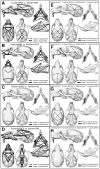Influence of prenatal EGCG treatment and Dyrk1a dosage reduction on craniofacial features associated with Down syndrome
- PMID: 28172997
- PMCID: PMC6049609
- DOI: 10.1093/hmg/ddw309
Influence of prenatal EGCG treatment and Dyrk1a dosage reduction on craniofacial features associated with Down syndrome
Abstract
Trisomy 21 (Ts21) affects craniofacial precursors in individuals with Down syndrome (DS). The resultant craniofacial features in all individuals with Ts21 may significantly affect breathing, eating and speaking. Using mouse models of DS, we have traced the origin of DS-associated craniofacial abnormalities to deficiencies in neural crest cell (NCC) craniofacial precursors early in development. Hypothetically, three copies of Dyrk1a (dual-specificity tyrosine-(Y)-phosphorylation regulated kinase 1A), a trisomic gene found in most humans with DS and mouse models of DS, may significantly affect craniofacial structure. We hypothesized that we could improve DS-related craniofacial abnormalities in mouse models using a Dyrk1a inhibitor or by normalizing Dyrk1a gene dosage. In vitro and in vivo treatment with Epigallocatechin-3-gallate (EGCG), a Dyrk1a inhibitor, modulated trisomic NCC deficiencies at embryonic time points. Furthermore, prenatal EGCG treatment normalized some craniofacial phenotypes, including cranial vault in adult Ts65Dn mice. Normalization of Dyrk1a copy number in an otherwise trisomic Ts65Dn mice normalized many dimensions of the cranial vault, but did not correct all craniofacial anatomy. These data underscore the complexity of the gene–phenotype relationship in trisomy and suggest that changes in Dyrk1a expression play an important role in morphogenesis and growth of the cranial vault. These results suggest that a temporally specific prenatal therapy may be an effective way to ameliorate some craniofacial anatomical changes associated with DS.
Figures







Similar articles
-
Rescue of the abnormal skeletal phenotype in Ts65Dn Down syndrome mice using genetic and therapeutic modulation of trisomic Dyrk1a.Hum Mol Genet. 2015 Oct 15;24(20):5687-96. doi: 10.1093/hmg/ddv284. Epub 2015 Jul 23. Hum Mol Genet. 2015. PMID: 26206885
-
Skeletal Deficits in Male and Female down Syndrome Model Mice Arise Independent of Normalized Dyrk1a Expression in Osteoblasts.Genes (Basel). 2021 Oct 28;12(11):1729. doi: 10.3390/genes12111729. Genes (Basel). 2021. PMID: 34828335 Free PMC article.
-
Normalizing the gene dosage of Dyrk1A in a mouse model of Down syndrome rescues several Alzheimer's disease phenotypes.Neurobiol Dis. 2017 Oct;106:76-88. doi: 10.1016/j.nbd.2017.06.010. Epub 2017 Jun 21. Neurobiol Dis. 2017. PMID: 28647555
-
The role of Goldilocks protein kinase DYRK1A in embryonic development.Dev Biol. 2025 Sep;525:216-228. doi: 10.1016/j.ydbio.2025.06.009. Epub 2025 Jun 10. Dev Biol. 2025. PMID: 40505942 Review.
-
Targeting trisomic treatments: optimizing Dyrk1a inhibition to improve Down syndrome deficits.Mol Genet Genomic Med. 2017 Sep 20;5(5):451-465. doi: 10.1002/mgg3.334. eCollection 2017 Sep. Mol Genet Genomic Med. 2017. PMID: 28944229 Free PMC article. Review.
Cited by
-
Sex-specific trisomic Dyrk1a-related skeletal phenotypes during development in a Down syndrome model.Dis Model Mech. 2024 Sep 1;17(9):dmm050914. doi: 10.1242/dmm.050914. Epub 2024 Sep 23. Dis Model Mech. 2024. PMID: 39136051 Free PMC article.
-
Rodent models in Down syndrome research: impact and future opportunities.Dis Model Mech. 2017 Oct 1;10(10):1165-1186. doi: 10.1242/dmm.029728. Dis Model Mech. 2017. PMID: 28993310 Free PMC article. Review.
-
Dyrk1a from Gene Function in Development and Physiology to Dosage Correction across Life Span in Down Syndrome.Genes (Basel). 2021 Nov 20;12(11):1833. doi: 10.3390/genes12111833. Genes (Basel). 2021. PMID: 34828439 Free PMC article. Review.
-
In vitro modeling for inherited neurological diseases using induced pluripotent stem cells: from 2D to organoid.Arch Pharm Res. 2020 Sep;43(9):877-889. doi: 10.1007/s12272-020-01260-z. Epub 2020 Aug 5. Arch Pharm Res. 2020. PMID: 32761309 Review.
-
Transcriptome research of human amniocytes identifies hub genes associated with developmental dysplasia in down syndrome.Aging (Albany NY). 2023 Dec 12;15(23):14086-14108. doi: 10.18632/aging.205291. Epub 2023 Dec 12. Aging (Albany NY). 2023. PMID: 38095646 Free PMC article.
References
-
- Borenstein M., Persico N., Kaihura C., Sonek J., Nicolaides K.H. (2007) Frontomaxillary facial angle in chromosomally normal fetuses at 11 + 0 to 13 + 6 weeks. Ultrasound Obstet. Gynecol., 30, 737–741. - PubMed
-
- Cicero S., Curcio P., Rembouskos G., Sonek J., Nicolaides K.H. (2004) Maxillary length at 11–14 weeks of gestation in fetuses with trisomy 21. Ultrasound Obstet. Gynecol., 24, 19–22. - PubMed
-
- Sonek J., Borenstein M., Dagklis T., Persico N., Nicolaides K.H. (2007) Frontomaxillary facial angle in fetuses with trisomy 21 at 11–13(6) weeks. Am. J. Obstet. Gynecol., 196, 271.e1–271.e4. - PubMed
-
- Allanson J.E., O'Hara P., Farkas L.G., Nair R.C. (1993) Anthropometric craniofacial pattern profiles in Down syndrome. Am. J. Med. Genet., 47, 748–752. - PubMed
MeSH terms
Substances
Grants and funding
LinkOut - more resources
Full Text Sources
Other Literature Sources
Medical
Molecular Biology Databases

